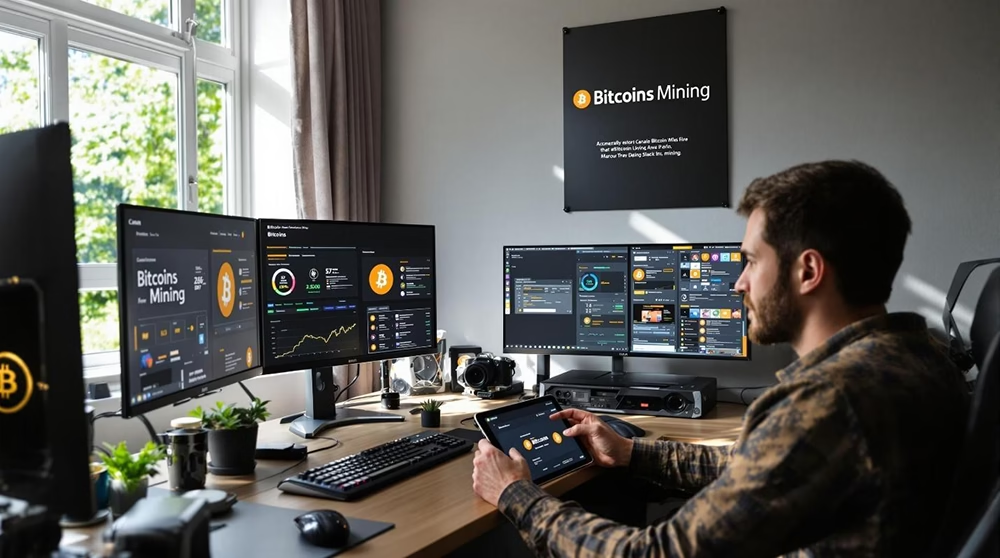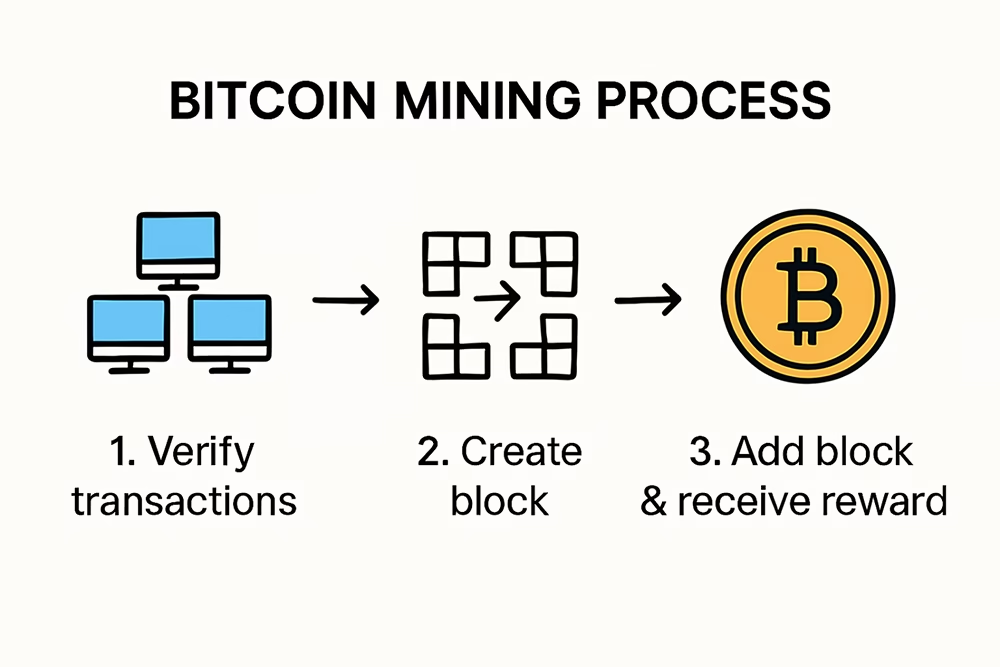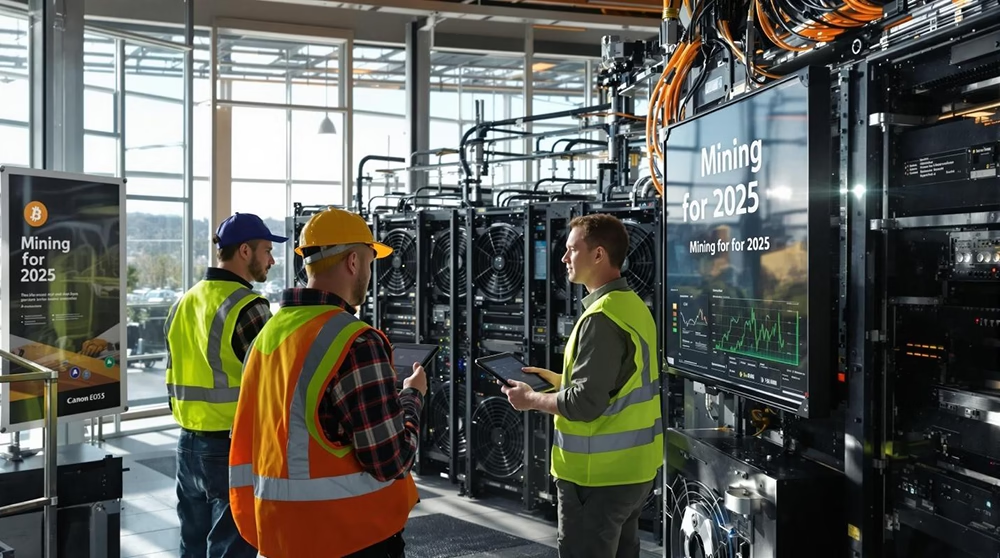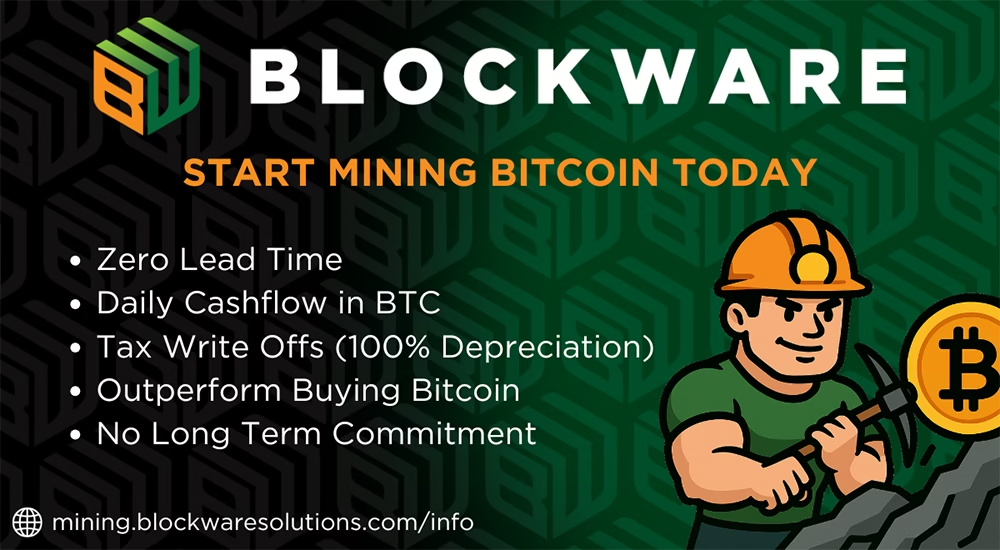
Bitcoin mining used to be something a few tech enthusiasts could do from their spare bedroom computers, but now it is a multibillion dollar global race with hardware investments reaching $10,000 per machine and power bills rising fast. Most people think the real battle is about who can solve the hardest math problems the fastest. What few realize is that the biggest winners in 2025 might be those who master energy and regulation, not just raw computing power.
|
Takeaway |
Explanation |
|
Bitcoin mining secures the blockchain |
Mining is essential for validating transactions and maintaining the integrity of the Bitcoin network. |
|
High performance hardware is crucial |
Successful miners use ASICs for unmatched processing power and energy efficiency. |
|
Profitability depends on multiple factors |
Miners must consider hardware costs, electricity expenses, and Bitcoin’s market value to assess returns. |
|
Invest in sustainable energy solutions |
Utilizing renewable energy sources can help mitigate environmental impact and reduce operational costs. |
|
Stay updated with regulatory changes |
Adapting to evolving regulations is vital for navigating the financial and environmental challenges in mining. |

Bitcoin mining represents a complex computational process that forms the backbone of the entire cryptocurrency network. At its core, mining is far more than just creating new bitcoins – it’s a critical mechanism that maintains the security, integrity, and decentralized nature of the blockchain.
Miners engage in a sophisticated computational competition where they use powerful computer hardware to solve intricate mathematical problems. According to Fidelity’s Cryptocurrency Insights, this process is called “proof of work” – a cryptographic challenge designed to validate and record transactions on the Bitcoin network.
The fundamental objective is to add new transaction blocks to the blockchain by solving complex algorithmic puzzles. These puzzles are intentionally difficult, requiring substantial computational power. Miners utilize specialized hardware like Application-Specific Integrated Circuits (ASICs) that can perform quadrillions of calculations per second to increase their chances of solving these mathematical challenges.
When a miner successfully solves a computational puzzle, they are rewarded with two primary incentives: newly minted bitcoins and transaction fees. TechTarget’s Cryptocurrency Research explains that this reward mechanism serves a dual purpose of creating new bitcoins in circulation and motivating miners to continue supporting the network’s infrastructure.
The complexity of these mathematical problems ensures that no single entity can manipulate the blockchain. Each solved block requires immense computational effort, making fraudulent activities extremely difficult and economically impractical.
As we approach 2025, bitcoin mining continues to evolve with increasing computational complexity and growing energy considerations. Miners must continually upgrade their hardware and optimize their strategies to remain competitive. The network automatically adjusts mining difficulty approximately every two weeks, ensuring a consistent block creation rate regardless of total network computational power.
This dynamic system maintains Bitcoin’s core principles of decentralization, security, and controlled supply. By requiring significant computational investment, the proof of work mechanism prevents easy manipulation while creating a fair, transparent system for transaction verification and bitcoin generation.
Learn more about our advanced mining solutions and discover how cutting-edge technology is transforming the cryptocurrency mining landscape.
|
Step |
Description |
|
Transaction Verification |
Collecting and verifying pending transactions from the network |
|
Block Creation |
Assembling verified transactions into a new block |
|
Computational Challenge |
Solving the cryptographic puzzle through intensive computational work |
|
Block Submission |
Adding the verified block to the blockchain |
Bitcoin mining requires sophisticated technological infrastructure that has dramatically transformed since cryptocurrency’s early days. Modern miners deploy an array of specialized hardware and software tools designed to maximize computational efficiency and mining profitability.
The cornerstone of successful bitcoin mining is specialized computer hardware engineered specifically for solving complex cryptographic puzzles. According to CoinDesk’s Hardware Analysis, miners predominantly utilize Application-Specific Integrated Circuits (ASICs), which represent the most advanced and efficient mining technology available.
Leading ASIC manufacturers like Bitmain, MicroBT, and Canaan produce powerful mining rigs that can cost between $2,000 to $10,000, representing a substantial investment for serious cryptocurrency miners.
Beyond hardware, miners rely on sophisticated software ecosystems to manage and optimize their mining operations. Bitcoin.org’s Technical Documentation highlights the critical role of mining software in connecting hardware to the blockchain network, managing worker configurations, and monitoring performance metrics.
Successful bitcoin mining extends beyond raw computational power. Professional miners must invest in comprehensive cooling and infrastructure solutions to maintain optimal hardware performance. High-performance mining operations generate substantial heat, requiring sophisticated cooling mechanisms to prevent equipment degradation.
Modern mining operations increasingly prioritize sustainable and energy-efficient approaches. Some miners are exploring renewable energy sources like hydroelectric and solar power to reduce operational costs and environmental impact.
Explore our comprehensive mining technology solutions and discover how cutting-edge infrastructure can transform your cryptocurrency mining strategy.
As the bitcoin mining landscape continues evolving, staying informed about the latest hardware and software innovations remains crucial for maintaining competitive mining operations in 2025 and beyond.
|
Tool/Component |
Purpose |
|
ASIC Mining Hardware |
Provides high-speed, energy-efficient computations |
|
Mining Pools Management Tools |
Coordinate resources across multiple miners |
|
Real-Time Performance Monitoring Systems |
Track hash rate, temperature, electricity usage |
|
Blockchain Network Connectivity Solutions |
Enable seamless connection to the bitcoin network |
|
Precision Temperature Control Systems |
Maintain optimal operating temperatures for mining hardware |
|
Specialized Ventilation Infrastructure |
Remove heat and stabilize environment |
|
Redundant Power Supply Configurations |
Ensure mining operations remain uninterrupted |
Bitcoin mining represents a complex financial ecosystem where potential rewards are intricately balanced against substantial risks and operational challenges. Understanding the economic landscape of cryptocurrency mining is crucial for investors and miners seeking sustainable returns in 2025 and beyond.
Profitability in bitcoin mining hinges on a delicate balance of multiple interconnected factors. According to Scientific Reports, the economic viability of mining has become increasingly nuanced, with climate damages and operational costs playing significant roles in determining net returns.
Miners must consistently calculate their potential returns by comparing electricity costs, hardware expenses, and current bitcoin valuations. The slim profit margins require sophisticated financial modeling and strategic decision-making.
Bitcoin mining confronts numerous risks that can rapidly erode potential profits. Britannica Money highlights several critical challenges miners must navigate:
Environmental concerns have become particularly prominent. Researchers found that each $1 in Bitcoin market value potentially creates $0.35 in global climate damages, underscoring the substantial ecological footprint of mining operations.
Successful miners in 2025 will need comprehensive strategies to manage inherent risks. Electronic Markets research suggests that profitability increasingly depends on operational efficiency and strategic investment.
As the bitcoin mining landscape evolves, miners must remain agile, technologically informed, and financially prudent. The most successful operations will prioritize efficiency, sustainability, and strategic adaptability.
Discover advanced mining risk management strategies and optimize your cryptocurrency investment approach for long-term success.

The bitcoin mining landscape is undergoing a transformative evolution, driven by technological innovations, environmental considerations, and economic challenges. As we approach 2025, miners and industry experts are reimagining the future of cryptocurrency mining through sustainable and technologically advanced approaches.
Environmental sustainability has become a critical focus for the bitcoin mining industry. According to research from ArXiv, emerging trends demonstrate a significant shift towards reducing the ecological footprint of cryptocurrency operations. Miners are increasingly exploring innovative strategies to balance technological progress with environmental responsibility.
The concept of “green bitcoin” is gaining momentum, with miners seeking to transform the industry’s environmental perception by implementing cutting-edge sustainable practices.
Advanced research published in ArXiv highlights the emerging trend of miners developing more sophisticated approaches to energy management. The industry is moving towards a model where mining operations can provide flexible load response to complement renewable energy generation.
Miners are increasingly viewing their operations as not just cryptocurrency generators, but as dynamic energy management platforms that can contribute to broader electrical grid stability.
Regulatory and Economic Landscape
The bitcoin mining ecosystem is experiencing significant regulatory and economic transformations. Environmental research indicates that governments and industry bodies are developing more comprehensive frameworks to address the environmental and economic challenges of cryptocurrency mining.
The future of bitcoin mining will likely be characterized by a delicate balance between technological innovation, environmental sustainability, and economic viability.
Explore our cutting-edge research on mining technologies and stay ahead of the cryptocurrency mining revolution.
As the industry continues to evolve, successful miners will be those who can adapt quickly, embrace technological innovations, and prioritize sustainable practices that align with global environmental and economic trends.
Bitcoin mining is the process of validating transactions and adding them to the Bitcoin blockchain through complex computational puzzles. Miners use powerful hardware to solve these puzzles and ensure the security and integrity of the Bitcoin network.
Miners earn by receiving rewards for solving computational puzzles. This includes newly minted bitcoins and transaction fees from the transactions they validate and include in the blockchain.
Profitability in Bitcoin mining depends on hardware investment costs, electricity expenses, Bitcoin’s market value, and the current mining difficulty level. Miners must consider these factors to assess potential returns.
Bitcoin mining involves various risks, including high energy consumption, equipment depreciation, market volatility, and regulatory uncertainties. Miners need to develop strategies to mitigate these risks for sustainable operations.
You just learned how Bitcoin mining is evolving in 2025. The competition is fierce. Rising hardware costs, energy expenses, and changing regulations can overwhelm even the most determined miner. The article made it clear that the winners are the ones who master both technology and strategic efficiency.
With Blockware Solutions, you can skip the guesswork and technical headaches. Our Mining-as-a-Service lets you start mining instantly with expert-hosted miners. Use advanced ROI tools, tap into our research hub, and enjoy concierge support. Take the next step and move from theory to daily mining results.

Seize your mining advantage now. Visit Blockware Solutions to launch your mining operation today. Are you ready to earn smarter and secure your spot in the future of crypto?